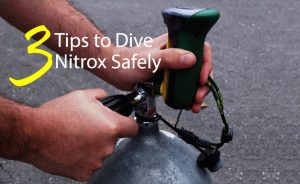3 Tips for Diving Nitrox Safely
by Cris Merz:
Diving with Nitrox has brought divers many benefits over the years including longer bottom times, shorter surface intervals, longer repetitive dives, and much more. However, with the good, comes the bad… often followed by the ugly. Nitrox has depth limitations because it increases the risk of oxygen toxicity, among other issues. It is a common misconception that Nitrox benefits deep divers during the dive.

The best way to prepare and plan is to follow three core tips when diving Nitrox.
- Analyze
- Label
- Set Computer
Once you have gone through these three steps, you can establish your maximum operating depth.
Analyze. Take the initiative and put the responsibility in your own hands. It is up to you, the diver, to confirm the mix you have in your tank. Since each “flavor” of Nitrox has a different MOD, you need to make sure yours is safe at your maximum depth and which partial pressure of oxygen is right for your conditions. Many experienced Nitrox divers use a PO2 of 1.6 in warm, calm water, but back the PO2 down to 1.4 in colder more challenging conditions.
Once your tank has been filled, the blender will either check the mixture in your cylinder for you – we advise you to watch – or have you check the mixture yourself. Either method is acceptable, provided you are satisfied that you have the correct gas mixture in your cylinder: because after all, it’s you that has to breathe it!
Label. To complete the process, mark the cylinder Contents label with date, FO2, MOD, Limiting PO2, dive operation name and the name or initials of the person conducting the analysis. Your signature indicates that you take responsibility for the Nitrox that has been delivered to you, and that you are satisfied that your cylinders have been filled properly.
It is important to analyze every cylinder and label the mix on each cylinder. While repeatedly stating this may seem redundant, we know that most Nitrox diving accidents occur when the diver grabs the wrong cylinder because it was not properly labeled, or fails to analyze the cylinder. You need to know what is in your cylinder prior to diving so that you can adequately plan your dive, set the mix in your dive computer and avoid an accident.
Set computer. Prior to every Nitrox dive, you must check your Nitrox dive computer to be sure that it is properly set for the mixture you are using. It is important to remember that there are two settings that you must take note of; the percentage of oxygen and the maximum PO2 to which you are willing to expose yourself. Remember, some dive computers, and their manuals use the term “FO2” (fraction of oxygen). In other words, 32% oxygen is the same thing as .32 FO2 in these cases.
While different dive computers have different default settings for both the oxygen percentage in the mix and the maximum PO2, most default settings tend to be conservative. In many cases, the default setting for the percentage of oxygen will be 21% while the default setting for PO2 is often 1.4. If you do not check these settings and adjust them to your dive plan you will not be getting the full benefit of the capabilities of your computer and Nitrox.
Excellent! You can now plan your maximum depth and bottom time. If you always remember to analyze, label, and set your dive computer to the settings according to your mix as well as your dive plan, you are good to go. And remember, when diving Nitrox; don’t dive below your MOD.
